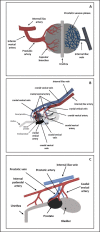In vivo prostate cancer research: Key interspecies prostate anatomical features for translation medicine
- PMID: 37545707
- PMCID: PMC10399646
- DOI: 10.5455/OVJ.2023.v13.i6.13
In vivo prostate cancer research: Key interspecies prostate anatomical features for translation medicine
Abstract
Prostate cancer (PCa) is a prevalent malignancy affecting men worldwide. Animal models play a crucial role in studying PCa pathology and discovering novel approaches to prevent, detect and treat this disease. However, the challenge of translational medicine is the limited reproducibility and inadequate recapitulation of human conditions in animal models. Therefore, a comprehensive understanding of the macroscopic and microscopic anatomy of the prostate gland among distinct animal species is essential for better translating research findings to clinical practice. This review aims to compare and describe the macroscopic and microscopic anatomy of the prostate gland in humans, rats, and dogs, emphasizing the relevant features. Despite the anatomical differences between these species, rats are a valuable model to study human prostate diseases, once they share some features implicated in carcinogenesis in humans. Dogs, on the other hand, are considered the best model for studying PCa due to the development of spontaneous cancer with a higher incidence when compared with other animals and the development of bone metastases. Moreover, the lymphatic system and the sentinel lymph node role and mapping are similar in dogs and humans. However, it is important to recognize that no animal model can directly mimic all aspects of PCa as the human prostate is anatomically different from that of rats and dogs. Therefore, it is essential to analyze and understand the intra- and interspecies variability when translating research findings into clinical practice. This review highlights the importance of a thorough understanding of the anatomical differences between the prostate gland in humans, rats, and dogs when selecting the appropriate animal model for studying PCa.
Keywords: Anatomy; Dog; Human; Prostate; Rat.
Conflict of interest statement
The authors declare that they have no conflict of interest.
Figures



Similar articles
-
Prostate cancer in dogs: comparative and clinical aspects.Vet J. 2009 May;180(2):149-62. doi: 10.1016/j.tvjl.2008.07.012. Epub 2008 Sep 10. Vet J. 2009. PMID: 18786842 Review.
-
Clinical and pathologic aspects of spontaneous canine prostate carcinoma: a retrospective analysis of 76 cases.Prostate. 2000 Oct 1;45(2):173-83. doi: 10.1002/1097-0045(20001001)45:2<173::aid-pros12>3.0.co;2-r. Prostate. 2000. PMID: 11027417
-
More advantages in detecting bone and soft tissue metastases from prostate cancer using 18F-PSMA PET/CT.Hell J Nucl Med. 2019 Jan-Apr;22(1):6-9. doi: 10.1967/s002449910952. Epub 2019 Mar 7. Hell J Nucl Med. 2019. PMID: 30843003
-
What is your diagnosis? Prostate neoplasm with metastases to bone.J Am Vet Med Assoc. 2013 Aug 15;243(4):483-5. doi: 10.2460/javma.243.4.483. J Am Vet Med Assoc. 2013. PMID: 23902439 No abstract available.
-
Animal models of bone metastasis.Cancer. 2003 Feb 1;97(3 Suppl):748-57. doi: 10.1002/cncr.11150. Cancer. 2003. PMID: 12548572 Review.
Cited by
-
In Vitro Antitumor Effect of Oils Rich in CBD and THC Cannabis Extract in Canine Prostate Carcinoma Cell Lines.Vet Sci. 2024 Oct 13;11(10):501. doi: 10.3390/vetsci11100501. Vet Sci. 2024. PMID: 39453093 Free PMC article.
-
An overview of stem cells and cell products involved in trauma injury.Regen Ther. 2025 Mar 11;29:60-76. doi: 10.1016/j.reth.2025.02.011. eCollection 2025 Jun. Regen Ther. 2025. PMID: 40143930 Free PMC article. Review.
References
-
- Abrahamsson P.A, Sant’agnese P.A.D. Neuroendocrine cells in the human prostate gland. J. Androl. 1993;14(5):307–309. - PubMed
-
- Adamowicz J, Pakravan K, Bakhshinejad B, Drewa T, Babashah S. Prostate cancer stem cells: from theory to practice. Scand. J. Urol. 2017;51(2):95–106. - PubMed
-
- Alonge S, Melandri M, Leoci R, Lacalandra G.M, Aiudi G. Canine prostate specific esterase (CPSE) as an useful biomarker in preventive screening programme of canine prostate: CPSE threshold value assessment and its correlation with ultrasonographic prostatic abnormalities in asymptomatic dogs. Reprod. Domest. Anim. 2018;53(2):359–364. - PubMed
-
- Annon. Brussels, Germany: European Commission; 2020. Report from the commission to the European Parliament and the council. 2019 report on the statistics on the use of animals for scientific purposes in the Member States of the European Union in 2015-2017; p. 21.
Publication types
MeSH terms
LinkOut - more resources
Full Text Sources
Medical
